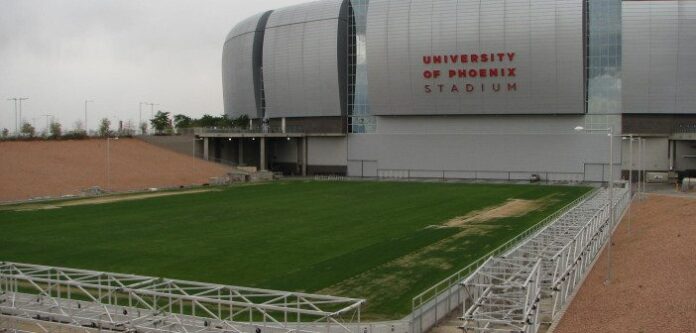Some football fans who work for Crown Castle, TE Connectivity, Galtronics, AT&T, Verizon, Sprint and T-Mobile US will be watching the Super Bowl carefully this weekend. They’ll be checking out the crowd shots and watching the fans who are glancing repeatedly at their laps. Keeping those smartphones connected is the job of the stadium’s distributed antenna system, and getting it ready for Super Bowl XLIX has been the job of wireless infrastructure vendors and integrators for months.
Crown Castle designed the DAS at the University of Phoenix stadium as a neutral host system, meaning that it can be shared by multiple wireless carriers. Verizon Wireless, AT&T Mobility, Sprint and T-Mobile US are all tenants.
The starting point
TE Connectivity, which recently agreed to sell its wireless infrastructure business to CommScope, is the stadium’s primary DAS equipment vendor. The company said that the system was originally deployed as a single layer with 33 independent zones. Each zone had 850/1900, 700/700, and 2100/2100 MHz frequencies, all run on standard power.
AT&T Mobility initially had 33 sectors in the 700 MHz band, and 33 in the 1900 MHz band. Its connections were farther from the headend than those of Verizon Wireless and T-Mobile US, the other original tenants.
T-Mobile US had connectivity at the DAS headend with 12 sectors each in the 1900 MHz band and the 2100 MHz band. Verizon Wireless had passive connections in a room next door, and 20 sectors in each of four bands: 700 MHz, 850 MHz, 1900 MHz, and 2100 MHz.
The upgrade
TE Connectivity has upgraded the stadium DAS to a two-layer standard power system. Layer one includes the 850/1900 MHz, 700/700 MHz, and 2100/2100 MHz spectrum bands. Layer two includes the 1900/2100 MHz, 800/1900 MHz, and 2100/2100 MHz bands.
There are now 48 independent zones and all antennas are shared. The deployment includes 96 main hubs, 49 expansion hubs and 225 remote antenna units to cover the stadium bowl, luxury boxes and service areas. In most highly trafficked areas, the antennas are out of sight, some disguised as air vents.
Galtronics’ 30⁰/30⁰ all-band stadium antenna, specially designed to allow high sectorization within a venue, were used extensively in the University of Phoenix stadium upgrade.
“Stadiums and arenas face an enormous challenge with events such as the Super Bowl: The massive amount of data traffic that is being generated demands systems with much higher wireless data capacity,” said Ephraim Ulmer, CEO of Galtronics.
The end product
Verizon Wireless now has three LTE bands connected inside and two connected outside the stadium via host-to-host. The carrier has technologies for all 48 sectors. AT&T Mobility has three LTE bands connected via host-to-host and has technologies for 44 of the 48 available sectors. It has tripled its network’s LTE capacity in the stadium area in preparation for the Super Bowl. T-Mobile US has two LTE bands and 30 sectors, and Sprint has two LTE bands and 15 sectors.
TE Connectivity has also deployed its digital DAS solution at US Airways Arena, site of the event’s media center. Host-to-host technology links a base station hotel in downtown Phoenix with US Airways Arena, the Hyatt Regency, Chase Field and the Phoenix Convention Center.
Meanwhile ExteNet Systems deployed DAS at the nearby Phoenix Sheraton Hotel and the Phoenix Westin. Each DAS has one anchor tenant, and ExteNet says it hopes to include all four of the major U.S. carriers on these neutral host systems.
Demand for coverage
The University of Phoenix Stadium is set to host more than 72,000 fans this weekend at Super Bowl XLIX. Most of them will bring smartphones and use them to share their experience with others. They will also use their phones to share what their friends at home are experiencing – the infamous Super Bowl ads. The NFL has even created a mobile app to let fans in the stadium watch the ads on their phones.
RCR’s Kelly Hill explored stadium Wi-Fi with TE Connectivity and InSite Wireless. Watch the conversation below:

